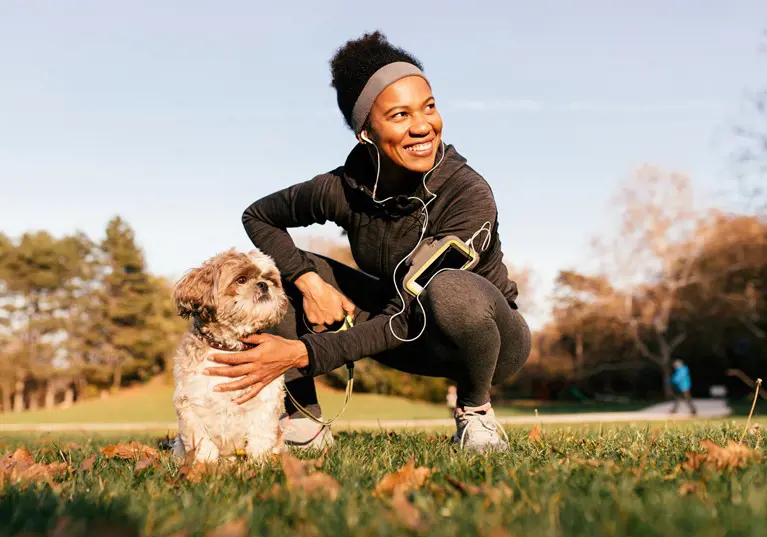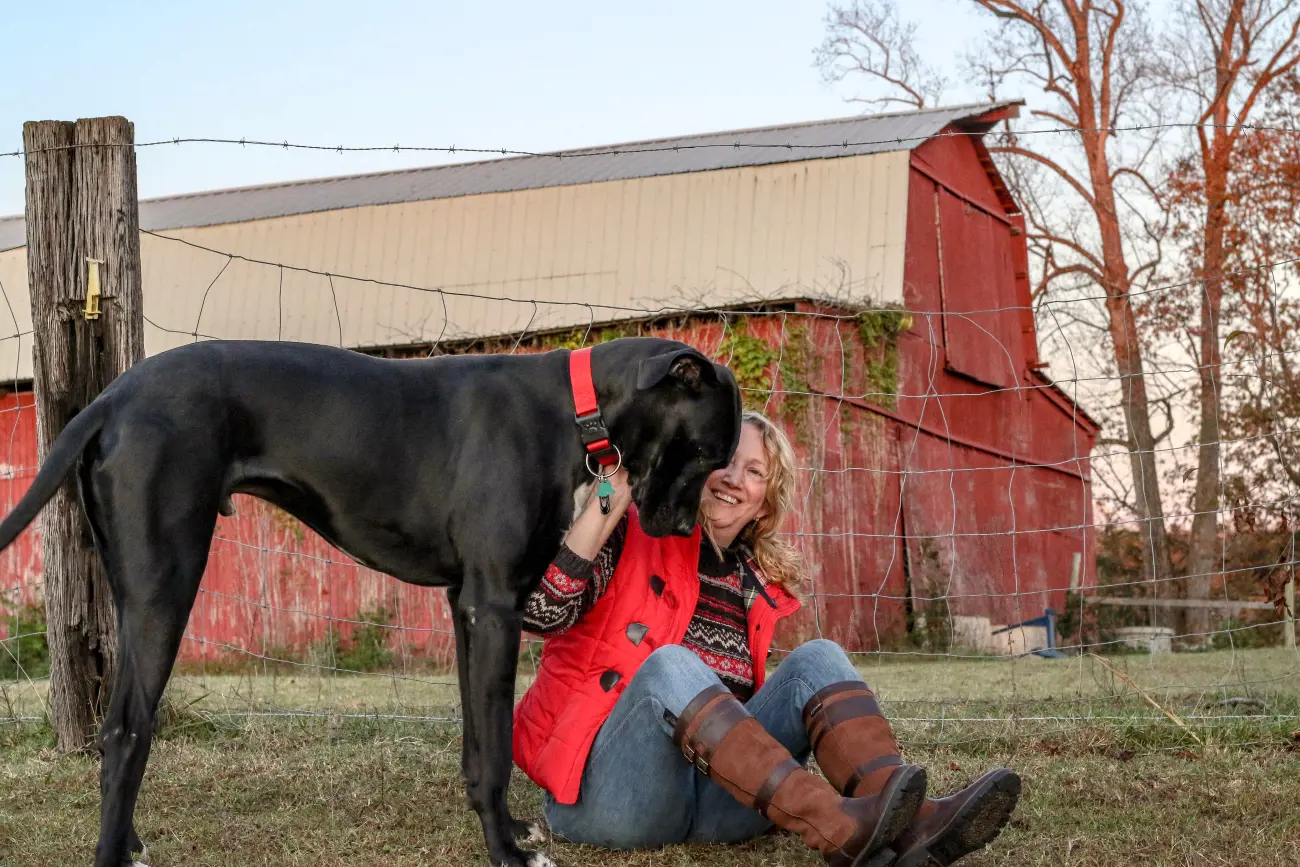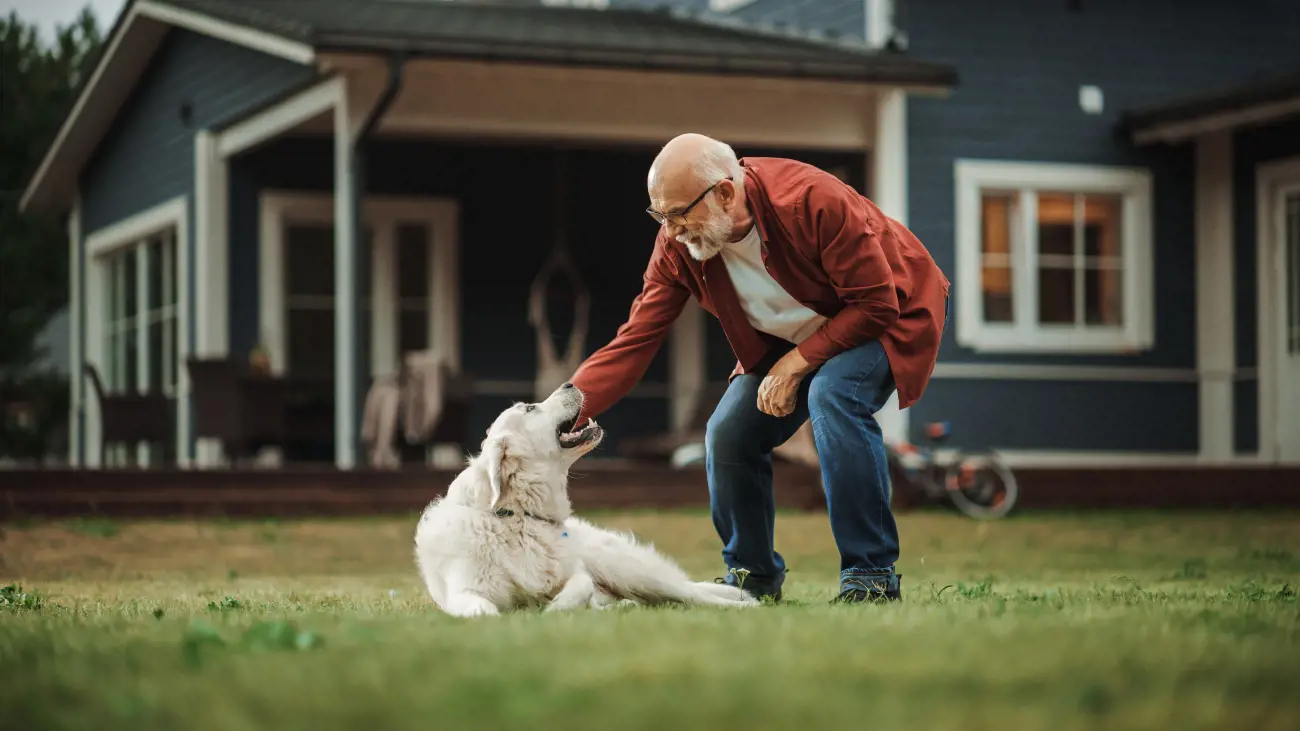How much exercise does my dog need?
26th October, 2022

As a dog owner, you know your four-legged friend needs its fair share of walkies, but just how much exercise is really necessary? Learn how often and how far to take your canine in this Purely Pets guide.
Whether you have a playful pooch who never sits still or a daydreaming dog who prefers to laze by the fireplace, they all need to get outside for daily walks.
The moment you decide to bring a pup into your home, you need to be prepared to meet its exercise goals come rain or shine. But do you know how long they should spend running around every day? And how far should you take them when it's bleak outdoors?
Find out how much a dog needs to walk each day depending on its breed and why it’s so important to get enough exercise. We also share some handy ways to encourage your hound to get the most out of its time in the open air and some other tips for an enjoyable walkie.
What if your pet isn’t as keen on getting outside as it once was? It may be suffering from an injury or illness and needs to see the vet.
At Purely Pets, we have 15 levels of lifetime dog insurance plans to choose from to protect your pup in times of need and help with the cost of emergency care.
Why is exercise important for dogs?
If your pup goes crazy at the mention of the ‘W’ word, you’re not alone. Most canines can’t wait to get their lead on and head out the front door.
Walking is an extremely important part of your dog’s routine, and it boasts a wealth of benefits to its wellbeing. Walking will…
- Boost their mood
- Help maintain a healthy weight
- Allow them to socialise
- Build a bond between you
- Promote healthy digestion
- Use up their energy
- Help them with training
- Lower the risk of health issues
- Give them something to look forward to
Let’s take a closer look at what each benefit can do for your pet.
Mood booster
Fresh air can do wonders for your canine’s overall mood, and it gives them a break from being shut indoors all day.
Exercise releases endorphins in your pup and greatly reduces the risk of it developing depression and restlessness.
Weight management
As your beloved pet ages, they are at higher risk of being overweight. Obesity leads to further health issues, like:
- Liver disease
- Osteoarthritis
- Stiff joints and limbs
- Insulin resistance
- Cardiovascular disease
It can be extremely challenging to get back to their normal fitness level once they reach this stage and you may find yourself claiming on your dog insurance plans more often because of associated health issues.
Regular walks stop them from piling on the pounds, which prolong their lives in general.
Chance to socialise
Canines are sociable by nature, and you’ve likely seen yours do its fair share of sniffing at the park. Walks are the perfect opportunity to get to know other dogs and make some new furry friends.
Strengthen your bond
Dogs have long been man’s best friend, and sharing long walks together is an excellent way to create a stronger bond and build the trust between you.
Aids healthy digestion
We’ve all suffered a bit of tummy trouble now and again, and dogs are just the same. Plenty of time outdoors gives them more opportunities to go to the toilet and can help relieve constipation.
Use up their energy
The more time a canine spends indoors, the more their energy builds up. When they don’t have the chance to release their energy, they may start to exhibit behavioural problems like destructive chewing, excessive barking, and scratching.
Help with training
When you get a new puppy, they often need lots of training. Walking is a great time to teach your four-legged friend obedience and discipline, both on and off the lead.
Lower risk of health issues
We’ve already mentioned how walks lower the risk of obesity. According to The Kennel Club, exercise is also “great for cardiovascular development, strengthening of muscles and bones and lowering blood pressure.”
When your dog is fit and healthy, they are less likely to develop medical issues. But if they do develop a problem, dog insurance plans may help cover the cost of treatment.
Something to look forward to
What would life be like if you had nothing to look forward to? Walks give your dog’s day structure and something to get excited about each morning and evening.
You might even see your pup sitting by its lead or the front door when they know it’s nearly time to go out.
How long should you walk your dog for a day?
According to a 2021 PDSA Animal Wellbeing Report, 13% of dogs in Britain don’t go for a daily walk. There may be reasons for this of course, such as medical conditions, dog’s age and owner’s physical ability.
At the other end of the spectrum, some pups were being over-exercised, leaving many wondering what the ideal amount of daily exercise for a canine is.
The reality is there’s no exact figure to suit every pup. It depends on your dog’s breed, with some needing only 30 minutes of exercise a day and others that require over 2 hours.
How much exercise they need will also depend on their age and overall health.
Of course, there are also some anomalies within the breeds.
Shorter dogs like Dachshunds may tire more easily with those little legs. And some larger canines like Greyhounds will require short, sharp bursts of exercise rather than hours and hours.
To help you get a better idea of what your pooch needs, we’ve broken them down into groups based on the amount of daily exercise they should get.
Dog breeds that need at least 30 minutes of daily exercise
As you can see from the breeds listed below, most smaller canines get enough exercise from a minimum of 30 minutes outside each day.
These dogs are ideal for older owners who can’t walk for long each day or those who don’t have as much time to take them out.
These breeds usually cost less throughout their lifetime, too, eating less than their larger counterparts. But you may still want to find a dog insurance plan for unexpected vet bills if your pooch falls ill or has an accident.
- Bichon Frise
- Chihuahua
- King Charles Spaniel
- Maltese
- Miniature Dachshund
- Miniature Pinscher
- Papillion
- Pekingese
- Pomeranian
- Yorkshire Terrier
Dog breeds that need at least 1 hour of daily exercise
Dogs that need at least one hour to exercise include a few smaller breeds but are mostly medium or large sized pups. They make the perfect pet for families who can only enjoy long walks at the weekend and who enjoy a furry snuggle on the sofa at night.
- Basset Hound
- Border Terrier
- Bull Terrier
- Cairn Terrier
- Cocker Spaniel
- Corgi
- English Bulldog
- Jack Russell Terrier
- Lhasa Apso
- Miniature Schnauzer
- Miniature/Toy Poodle
- Saint Bernard
- Shetland Sheepdog
- Shih Tzu
- Staffordshire Bull Terrier
- Tibetan Terrier
- West Highland Terrier
- Whippet
Dog breeds that need at least 2 hours of daily exercise

The breeds that need the most exercise a day are usually larger and have very playful personalities.
They have a lot of energy they need to let out and can sometimes spend much more than the two hours minimum outdoors. You must have an active lifestyle if you plan on bringing one of these dogs into your home.
- Alaskan Malamute
- Border Collie
- Boxer
- Dalmatian
- English Springer Spaniel
- German Shepherd
- Golden Retriever
- Labrador Retriever
- Samoyed
- Siberian Husky
- Weimaraner
How far should you walk a dog every day?
Just like with the amount of time a dog needs to exercise daily, the distance they should walk also varies. Most breeds will be happy with one to three miles at a time, but larger canines may be able to go much further.
Bear in mind that their lead length makes a massive difference. If you keep your dog on a short lead, it will walk a similar distance to you. When they have an extendable lead, they can sometimes cover twice what you do as they run ahead and double-back on themselves.
Ideally, playful pooches who need to expend a lot of energy should go to large parks and woodlands where they can enjoy plenty of time off the lead to run around.
If you need some inspiration for places to take your dog where they can run freely, The National Trust and Walkiees both have plenty of options to choose from.
Top tip
When you have a puppy, never take them out for more than a couple of miles until they grow. Concentrate on the time outside rather than the distance they cover and let them set the pace.
Remember, if your active dog suddenly becomes less excited about walkies and seems to have lower energy levels, take them to the vet. It could be a sign they’ve injured themselves or have an underlying illness that needs treatment.
If you have one of the dog insurance plans from Purely Pets, you can use our unlimited vet video consultation 24/7 to get quick professional advice from a qualified vet.
How many walks should dogs have a day?
For most breeds, two walks a day is enough, along with other exercise opportunities like playing with a toy, in the morning and night.
Herding dogs, like Collies and Corgis, may differ on the amount of walks that they need, while hound dogs like Dachshunds and Afghans are sometimes happy with just one longer run.
Dog walking needs depending on the breed
With all the information above, you might be trying to calculate exactly how far, long, and often you need to walk your dog.
To make it a bit easier, we’ve condensed the information into a table to find your dog’s breed and walking requirements.
Remember, every dog is different and the amount of exercise your dog needs will depend on its age and overall health. Check with a vet on how much exercise your specific pet needs.
| Non-sporting and toy breeds | |||
|
|
|
|
| Small terriers | |||
|
|
|
|
| Herding breeds | |||
|
|
|
|
| Sports/working breeds | |||
|
|
|
|
| Hound dogs | |||
|
|
|
|
| Large breeds | |||
|
|
|
|
Is walking enough exercise for a dog?
This really depends on your pet and how they act after a walk. If, at the end, they are still pulling on the lead and seem over-excited, it’s likely they need more exercise.
If your pup slows down as you go and enjoys a long nap when it gets home, its exercise needs are probably being met.
It’s important to note that this isn’t the only time your dog needs to go outdoors in a day. A canine should never go more than 8 hours without going to the toilet, which means you may need to let them out in the garden or go for a brief stroll around the block a few times a day.
If your pet can’t wee regularly, they are at much higher risk of developing a urinary tract infection (UTI) and becoming ill.
They also run the risk of severe constipation, leading to megacolon, which requires surgery. This could mean a huge medical bill from the vet if you don’t have one of our dog insurance plans in place to help with the cost of emergency treatment.
Ways to give your dog more exercise
If you have one of those dogs that never seems to tire after a walk, you might have to think of more ways to make sure it gets the exercise it needs.
Consider the following ways to boost your pup’s activity levels.
Take them on a run – If you enjoy going out for a jog, why not take your dog with you?
Play a game of fetch – This canine classic works at home, in a park or on the beach! Grab a ball, stick or frisbee and throw, throw and throw again until your pooch tires itself out.
Visit more parks – You’ll be much more likely to come across other playful pups at a park than along the high street. Dogs love being social and are usually good at coming up with fun games together like tag and racing.
Try hide and seek – Another great way to get your pet to exercise more at home is to hide around the house and call their name. It not only encourages them to get moving but also stimulates them mentally when they have to sniff you out.
Encourage them to swim – A lot of dogs love swimming, so if your pooch is a confident swimmer, search for spots in your area where dogs are allowed to jump in and it’s safe to do so, for a little paddle. Just be careful with older dogs and those with arthritis. Make sure they always have easy access out of the water so they don’t become too tired.
Consider agility classes – If your pet still has loads of energy, consider taking them to agility classes. You get to work out together and keep fit at the same time.
Tips for walking your dog
Canines need plenty of exercise every day, and walking helps them stay fit and healthy while having lots of fun. How can you make sure walkies are always safe and enjoyable for both you and your four-legged friend? We have some expert tips to help.
Have the right equipment
There are a few walking essentials that every dog owner should take out with them whenever they leave the house:
Snacks and treats for hunger pangs and to reward good behaviour.
Toys to play fetch and tug of war with.
A portable water bottle and bowl for when it gets thirsty.
Poo bags to keep streets and parks clean.
A bum bag or small backpack to keep your keys, phone, and other essentials in and to make sure you have your hands free to hold the lead and play.
Choose the right collar and lead
Your pet’s collar and lead are the most important part of your walking kit – they help you control your pup and teach discipline and obedience.
Leads should be comfortable, give you control, and be so that you can extend and give your pet more freedom when possible.
When it comes to choosing between a collar or harness, most experts agree that the latter is more comfortable for your pup. It also reduces the risk of choking if your animal tends to pull on the lead or slips and is left dangling in the air.
To protect your pup and make sure you can afford urgent care if an emergency happens on a walk, take a look at our dog insurance plans today.
Reward good behaviour
Taking an untrained dog for a walk can be stressful for you both. It might upset other pets and their owners or even get into a dangerous situation running through livestock.
If your four-legged friend runs away when you call or is prone to getting a bit too friendly with other canines at the park, it’s time to start teaching them what’s right and wrong.
According to Rosie Bescoby, you should reward your dog when they’re by your side or voluntarily come to check in with you. This encourages them to engage with you often and to come when called.
Keep an eye on the weather
Your dog needs exercise, but on a hot day it is better to walk your dog outside in the evening when it is cooler. Before you leave home, look at the forecast.
In warm weather, it’s better to take longer walks in the evening when it’s cooler. If it’s icy outside, try to keep them close by to avoid slipping and wipe their paws when you get in as there might be grit on them. If there’s a possibility that your pet has walked in anti-freeze and road grit, it’s important to ensure they do not lick their paws and give them a wash as soon as you get home.
Don’t forget to keep an old towel by the front door in case you get caught in an unexpected shower or they enjoy a roll in the mud!
Ask before interacting with other dogs
You might have the friendliest canine companion on the planet, but not all dogs (or their owners) are as willing to be sociable. Some hounds might be shy while others are prone to fight.
Always keep a safe distance from other dogs and ask if it’s OK to approach if your pet seems keen.
Look after your dog with lifetime insurance from Purely Pets

There’s no doubt all canines need exercise to stay fit and healthy, but accidents can happen while you’re out on a walk and you’ll have to take your pet to the vet.
Dog insurance plans can help you cover the costs of medical bills and treatment in an emergency, so your four-legged family member gets the care they deserve.
At Purely Pets, we protect dogs from as young as 8 weeks old, and there’s no upper age limit. We have 15 levels of lifetime cover to choose from and our policies are easy to manage online.
With our dog insurance plans, you get access to our 24/7 vet video consultation service for quick and professional advice from a vet.
Whether you have a playful puppy or a golden oldie, contact Purely Pets today to protect your faithful friend.
Helpful Pages
Recent Posts

Why do Great Danes bury their heads?
12/03/25
Find out more about Beagles
28/02/25Pet Insurance Quote
- 98% claims paid *
- Claims paid directly to vets
- 24/7 vet video consultations
- Interest free monthly payments


